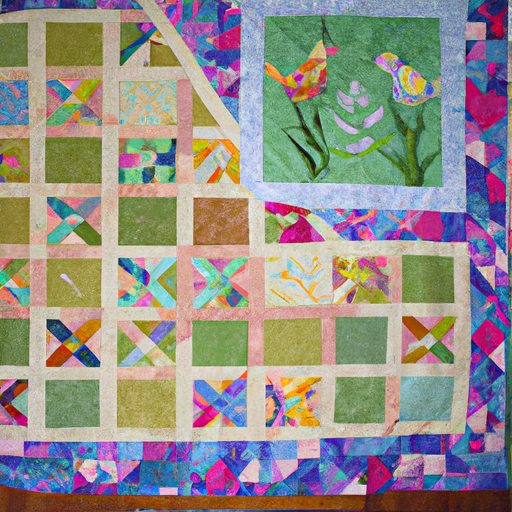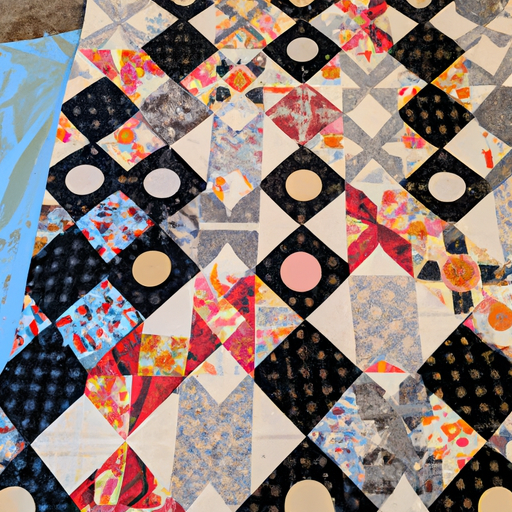
Can you quilt with any fabric?
As a lover of all things fabric, the thought of not being able to use a certain material for quilting breaks my heart. The idea that some varieties may not be suitable is downright distressing. I mean, what if that exquisite silk scarf you inherited from your grandmother is off-limits? What if that groovy polyester shirt you found at a thrift store can’t be included in your masterpiece? The horror! But fear not, dear reader, for we are about to embark on a journey to uncover the truth behind the age-old question: can you quilt with any fabric? Buckle up, this emotional rollercoaster is about to begin.
1. The Ultimate Fabric Dilemma: Can You Really Quilt with Any Material?
For us quilters, every piece of fabric holds a story. Whether it’s from a yard sale, a thrift store, or a donation from friends, the fabric resonates with us on an emotional level. But the question remains, can you quilt with any material?
Let’s be real, there are no rules in quilting. You can make a quilt out of anything, whether it’s old t-shirts or even paper. But just because you can, doesn’t mean you should. There are some fabrics that work better than others when it comes to quilting.
- Cotton: This is the go-to material for quilters. It’s lightweight, easy to sew with, and comes in a wide variety of prints and colors.
- Flannel: This soft and cozy material is perfect for winter quilts. However, it can be a bit tricky to work with since it stretches and frays easily.
- Silk: While silk can make for a beautiful quilt, it’s not the easiest material to work with. It wrinkles easily and can be challenging to cut and sew.
But the real dilemma comes when you have a fabric that you just can’t resist, but you’re not sure if it’s suitable for quilting. Maybe it’s a thick, woolen fabric or a delicate lace. In these cases, it’s important to test the fabric before you commit to using it in your quilt.
So, can you quilt with any material? The answer is yes, but it’s important to consider the qualities of the fabric and how it will affect your overall quilt. As quilters, we have the power to turn any piece of fabric into a work of art. So go ahead, follow your instincts, and let your creativity run wild!
2. The Debate Around Quilting Fabric: Experimentation vs Traditionalism
The Great Quilting Fabric Debate: To Experiment or Stick to Tradition?
For years, quilters have battled over the proper way to approach quilting fabric. Some swear by traditional techniques, using only classic materials and patterns to create their masterpieces. Others take a more experimental approach, incorporating all sorts of fabrics and patterns into their designs. But which side is right? That’s a question that may never be fully answered.
On the one hand, traditionalism brings with it a certain sense of history and nostalgia. For many quilters, using authentic, period-appropriate fabrics is a way to pay homage to the craft’s roots and the legacies of past quilting masters. There’s also something incredibly satisfying about piecing together a quilt using only a few simple fabrics and patterns, knowing that you’re upholding generations of tradition.
On the other hand, experimenting with different fabrics and patterns can be an incredibly fun and rewarding experience. By incorporating unexpected materials into your designs, you can create truly unique and eye-catching quilts that stand out from the crowd. Plus, the possibilities are endless – why limit yourself to just a handful of fabrics and patterns when there are so many amazing options out there?
Ultimately, the decision to stick with tradition or branch out into new territory is a deeply personal one. Some quilters will always prefer the tried-and-true methods of the past, while others will forever be drawn to the thrill of experimentation. And that’s okay – as long as we all continue to share our love of quilting and respect each other’s creative choices, we can keep pushing the bounds of this incredible craft for years to come.
3. Breaking Boundaries: Exploring the Possibility of Unconventional Quilting Fabrics
Quilting is an art form that has been around for centuries. It’s a way of telling stories and expressing oneself through fabric. Traditionally, quilting fabrics have been limited to cotton, wool, and silk. However, in recent years, quilters have begun to explore the possibility of using unconventional materials in their work.
One such material is denim. Denim is a durable fabric that can give quilts a rustic, vintage feel. It’s also a great way to upcycle old jeans and give them new life. Quilts made from denim can be washed and worn for years, making them practical as well as beautiful.
Another unconventional material is leather. Leather gives quilts a luxurious, high-end feel. It’s also a great way to add texture to a quilt. Leather can be cut into shapes and sewn onto fabric, or used as an applique. Quilts made from leather are perfect for adding warmth and elegance to a room.
Yet another unconventional material is tulle. Tulle is a lightweight, semi-transparent fabric that can add a soft, feminine touch to a quilt. It can be used as a layer over other fabrics, or to create a light, airy effect. Quilts made from tulle are perfect for adding a touch of whimsy to a room.
In conclusion, breaking boundaries and exploring new materials is what makes quilting so exciting. The possibilities are endless, and with a little creativity, any material can be used to create a beautiful and unique quilt. So why limit yourself to traditional fabrics? Go ahead, break the rules, and explore the world of unconventional quilting!
4. From T-Shirts to Denim: How to Make Your Wildest Fabric Dreams a Quilting Reality
Quilting is not just a hobby, it’s a form of art that allows you to create something beautiful and meaningful from your wildest fabric dreams. From T-shirts to denim, the possibilities are endless! Here are some tips to help you turn your ideas into a quilted reality:
1. Choose your fabrics carefully. Rather than focusing on a specific color, think about the textures and patterns you want to incorporate. Whether you’re cutting up old jeans or using a variety of printed fabrics, they should complement each other and create a cohesive design.
2. Experiment with different quilting techniques. There’s no one „right“ way to quilt, so don’t be afraid to try something new! From traditional stitching to free-motion embroidery, there are many techniques that can add depth and texture to your quilt.
3. Incorporate personal touches. Want to make your quilt even more special? Consider adding meaningful details like patches, buttons, or embroidery. You can also add a personal touch by incorporating fabric from old clothing or other sentimental items.
4. Don’t be afraid to make mistakes. Quilting is a process, and it’s natural to encounter challenges along the way. Instead of getting discouraged, embrace the mistakes and use them as opportunities to learn and grow.
5. Enjoy the process! Quilting is a labor of love, so don’t forget to have fun along the way. Whether you’re working on a large quilt or a small project, savor the time you spend creating something that reflects your personal style and vision.
5. The Joy of Quilting with Unexpected and Emotionally Significant Textiles
Quilting is not only a craft that requires skill and patience but also one that can evoke emotions and memories. Working with unexpected or emotionally significant textiles can take the joy of quilting to a whole new level.
It may be an old sweater of your grandfather, a scarf from a loved one, or a piece of fabric with a special meaning to you. Using these textiles as a part of your quilt can breathe new life into them and create a lasting sentimental value. The sentimental textile can be the theme or inspiration for the whole quilt or incorporated as a special block or detail.
The texture, color, and pattern of unexpected textiles can add unique and eye-catching elements to your quilt. For example, an old denim jacket that has not been worn for years can create a rustic and vintage feel to your quilt. A silk shirt with stunning embroidery can add a touch of elegance and a glimpse of the original owner’s personality.
Creating a quilt with unexpected textiles can also be a great way to tell the story behind them. You can write a little note or create a label explaining where the textile came from, the significance behind it, and the person who owned it. This makes your quilt not only a work of art but also a cherished family heirloom.
In conclusion, quilting with unexpected and emotionally significant textiles can bring you a sense of connection to the past and the people you love. It is a way to create something beautiful and practical while preserving memories and stories. So, dive into your closets and hunt for that perfect sentimental textile to incorporate into your next quilt.
6. The Power of Creativity: Why Quilting with Any Fabric Can Ignite Your Passion for Sewing
Creativity awakens passion and brings life to our soul! That’s the magic of quilting with any fabric. The power of creativity ignites our inner spark and leads us to a world of imagination. Quilting is more than just a hobby; it’s a therapeutic process that soothes our minds and feeds our souls.
When you engage in quilting, you get to choose the colors, patterns, and designs that inspire you. You can mix and match contrasting fabrics or go for a more subtle look, the possibilities are endless. Your creation is a reflection of your unique taste and style. That’s what makes quilting so special; it’s your chance to express yourself in a way that’s meaningful and fulfilling.
Quilting with any fabric is not just about crafting, it’s also a way to connect with others who share the same passion. It’s a chance to collaborate, exchange ideas, and learn new techniques. Quilting communities offer a supportive, inspiring and nurturing environment that fosters growth and creativity. So whether you’re a beginner or an experienced quilter, there’s always something new to discover and explore.
At its core, quilting is a form of art that celebrates tradition, beauty, and comfort. It’s a reminder of our roots and a testament to our resilience. Quilts have been passed down through generations, carrying with them stories of love, sacrifice, and perseverance. When you quilt with any fabric, you’re not just creating a piece of cloth; you’re creating a piece of history that can be cherished for years to come.
In conclusion, the power of creativity is a force to be reckoned with, and quilting with any fabric is a perfect way to ignite it. So let your imagination run wild and discover the joy and fulfillment of quilting. As I wrap up this journey of exploring the question, „“ I cannot help but feel a sense of wonder and amazement at the artistry and diversity of this craft. From silk to flannel, velvet to denim, and everything in between, the possibilities are endless. The decision to use any particular fabric is subjective, and ultimately depends on the quilter’s vision for their creation. But one thing is for certain – the love and passion that goes into quilting transcends any material, and it is this devotion that truly makes a quilt a work of art. So, to answer the question – can you quilt with any fabric? Absolutely. With creativity, patience, and a little bit of faith, any fabric can become a masterpiece. Happy quilting!